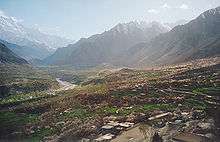Ganish
| Ganish | |
|---|---|
| Country | Pakistan |
| Region | Gilgit–Baltistan |
| District | Hunza |
| village | Ganish |
| Elevation | 2,240 m (7,500 ft) |
| Time zone | UTC+5 (PST) |
| • Summer (DST) | UTC+6 (PDT) |

Ganish is a village in Pakistan.[1] It is the oldest and first settlement on the ancient Silk Road in the Hunza Valley, and is the site of various ancient watch towers, traditional mosques, religious centers, and a reservoir. It is located 90 km and 2.5 hours traveling time from Gilgit. Ganish means gold in Brushaski.
The Ali Gohar House in Ganish, is located next to one of the iconic shikari watchtowers of the town. The 400-year-old house was awarded the UNESCO Asia-Pacific Awards for Cultural Heritage Conservation in 2009.[2]
Sub-villages
The sub-villages of Ganish include Garelth, Chaboikushal, Shukunoshal, Gamun Ganish, Buldas and Chillganish.
Chillganish is a sub village of Ganish. There are 25 families living here. Chillganish is one of the most ancient villages of Ganish which has rich history. The residents of Chillganish belong to well-known tribe Chillganishkuz. The word chill means water and Ganiskuz means residents of Ganish. Sheikh Ali was a prominent cleric in Chillganish and Haji Muhammad Bilal (late) was main leader from the area who was also the first Haji (pilgrim of Kab'a) from Hunza. Jamia tul Zehra is the main institution for education in Chillganish.
Garelth is also a sub-village of Ganish with a population of about 135 families. FG Boys Middle School, Aga Khan Diamond School are the main educational institutions. Former Member District Council Gilgit Baltistan Jan Alam, Former Chairman Village Council Darvesh, and Muhammad Ali Barcha have been leading politically. Currently Ghulam Mustafa Barcha, grandson of Major Ghulam Murtaza is Chairman of Garelth Hunza.
Subedar Major Fida Ali, one of the main leaders of independence movement of Gilgit-Baltistan, belongs to this village. Fida Ali played a key role in the independence of Gilgit-Baltistan. He was a key figure who launched the freedom movement against the Dogra dynasty in Gilgit. Major Ghulam Murtaza (Sitara-e-Jurat), a key person in the revolution of independence movement of Gilgit-Baltistan, also belongs to this village. He made major gains by leading troops into India. His graveyard is located next to KKH at Garelth.
Religion
Ganish is home to a four hundred-year old mosque.[3]
See also
koten City
References
- ↑ Archived October 2, 2009, at the Wayback Machine.
- ↑ "Archived copy". Archived from the original on 2017-03-28. Retrieved 2012-11-12.
- ↑ Salopek, Paul (January 29, 2018). "Relict Walls of the Ancient Silk Road". National Geographic Society. Archived from the original on January 30, 2018.
The ornately carved door of a 400-year-old mosque in Ganish, Pakistan. Before Islam, the region was Buddhist, and before that Zoroastrian—a testament to the tides of ideas moving along the Silk Road.